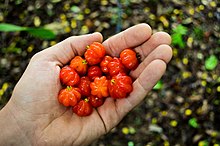Suriname cherry
The Suriname cherry (Eugenia uniflora),[2] also known as the pitanga, Brazilian cherry,[2] Cayenne cherry,[3] or Cerisier Carré[2][4] is a plant which mostly grows on the eastern coast of South America. It is in the family Myraceae (the myrtles). The plant may look like a cherry, but is not related to true cherries. The Suriname cherry can be found from Suriname, French Guiana to southern Brazil, as well as parts of Paraguay, Argentina and Uruguay.[4][5][6] It is known as pitanga throughout Brazil and Uruguay, or ñangapirí in surrounding countries. The plant is relatively easy to grow, resists pests well, and is high in antioxidants.[7] The tree is also grown in the West Indies, specifically in Haiti, where it is known as Cerisier Carré, as is in French Guiana.[4] The Suriname cherry is often used in gardens as a hedge or screen. The tree was introduced to Bermuda for ornamental purposes but is now out of control and listed as an invasive species.[8] In Suriname this cherry is known as Monkimonki Kersie, also Montjimontji Kersie. The tree has also been introduced to Florida.[9]
| Surinam cherry | |
|---|---|

| |
| Scientific classification | |
| Kingdom: | Plantae |
| Clade: | Tracheophytes |
| Clade: | Angiosperms |
| Clade: | Eudicots |
| Clade: | Rosids |
| Order: | Myrtales |
| Family: | Myrtaceae |
| Genus: | Eugenia |
| Species: | E. uniflora
|
| Binomial name | |
| Eugenia uniflora | |
| Synonyms[1] | |
|
List
| |
| Nutritional value per 100 g (3.5 oz) | |
|---|---|
| Energy | 138 kJ (33 kcal) |
| Carbohydrates | 7.49 g |
| Fat | 0.4 g |
| Protein | 0.8 g |
| Vitamin A equiv. | 75 μg (8%) |
| Thiamine (Vit. B1) | 0.03 mg (2%) |
| Riboflavin (Vit. B2) | 0.04 mg (3%) |
| Niacin (Vit. B3) | 0.3 mg (2%) |
| Vitamin C | 26.3 mg (44%) |
| Calcium | 9 mg (1%) |
| Iron | 0.2 mg (2%) |
| Magnesium | 12 mg (3%) |
| Phosphorus | 11 mg (2%) |
| Potassium | 103 mg (2%) |
| Sodium | 3 mg (0%) |
| Link to USDA Database entry Percentages are relative to US recommendations for adults. Source: USDA Nutrient database | |
References
change- ↑ "The Plant List: A Working List of All Plant Species". Archived from the original on December 14, 2018. Retrieved March 7, 2014.
- ↑ 2.0 2.1 2.2 "Eugenia uniflora". Germplasm Resources Information Network (GRIN). Agricultural Research Service (ARS), United States Department of Agriculture (USDA). Retrieved 27 December 2014.
- ↑ "Weeds of Australia: Eugenia uniflora". Queensland Government. Retrieved 25 April 2018.
- ↑ 4.0 4.1 4.2 Duke, James A. (2009). Duke's Handbook of Medicinal Plants of Latin America. p. 309. ISBN 9781420043174. Retrieved 12 June 2015.
- ↑ Berry Helped to Put Reality Show Chef on Top - New York Times
- ↑ Morton, Julia (1987). "Surinam cherry". Fruits of warm climates. Miami, FL. pp. 386–388.
{{cite book}}: CS1 maint: location missing publisher (link) - ↑ A curious crop | The Honolulu Advertiser
- ↑ "Bermuda Conservation - Surinam Cherry". Archived from the original on 2012-02-05. Retrieved 2019-01-14.
- ↑ "Surinam Cherry: Only Ripe Need Apply". 24 September 2011. Retrieved April 28, 2017.